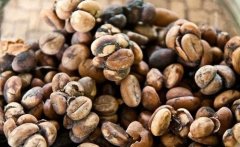Varieties of Yunnan boutique coffee beans the old variety Tieka and the new variety Katimo Yunnan boutique coffee

The Root-seeking Journey of Coffee in Yunnan-- the Old Variety Iron pickup & the New Variety Katimo
When it comes to Yunnan coffee, perhaps the most common word we hear is "Yunnan small-grain coffee", and most of them will say "Yunnan small-grain coffee-fragrant but not bitter, strong but not strong", so many people classify the varieties of Yunnan coffee as "small-grain species". The evaluation of the taste of Yunnan coffee is naturally "fragrant but not bitter, strong but not strong". Regardless of whether it is correct or not, there is no word "small seed" among the more than 900 named coffee varieties at present, so this "small seed" is not strictly a coffee variety, it is just a nickname given to this variety by the people of Yunnan. In fact, the name of Yunnan "small grain coffee" should be called arabica--typica (Arabica-iron pickup). Or arabica--bourbon (Arabica-bourbon).
Tracing back to its roots, typica originated from Ethiopia, the ancient origin of coffee, and is the earliest original species of coffee. Bourbon is a variety of typica, both of which have rich aroma and excellent taste performance, and belong to very high quality varieties in Arabica. It is said that the coffee tree species that was first introduced into Zhukula in Yunnan is typica. When coffee was planted on a large scale in Baoshan area in the 1950s, it was also typica and bourbon. But the problem is that although these two varieties have excellent taste, they are not resistant to diseases and insect pests, are prone to leaf rust, and the yield per mu is relatively low, so corresponding to this, there are "new varieties".
The so-called new variety actually refers to catimor (Katimo), which is the hybrid of timor and Arabica of the Roberta family. Compared with the old variety, it lacks rich aroma and taste, and has a relatively shallow smell of grass and soil, but it has the advantages of resistance to diseases and insect pests, easy to manage, large yield, and its yield per mu can reach up to 350kg raw beans, which is more than twice that of the old variety.
So when Nestl é succeeded in promoting high-yield new varieties in Pu'er in the 1990s, brown farmers in Baoshan also cut down old varieties and changed them to new ones. With a round of coffee expansion, new varieties are increasing and old varieties are decreasing day by day. Finally, today's situation: the old varieties have almost been cut down, and the little ones that survived are all "old, weak, sick and disabled". Most of the trees are more than 20 years old. Over the years, the output and quality are not as good as they used to be.
Of course, if it is used to make instant coffee or general commercial beans, high-yield catimor is a good choice, but if you want to look for Yunnan specialty coffee, then the old variety of iron pickup has become the first choice because of its congenital excellent genes. Therefore, this trip to Yunnan also followed the trail of the old varieties. But the reality is really cruel. Before going, Brother Zou told me that there was an old variety in his relative's house, but what he saw excitedly was a crazy growing coffee forest, which belonged to his aunt. Because the aunt was too old and did not have the strength to replant and renovate-- these old varieties survived, but the aunt was unable to manage it alone, so he let the tree grow naturally and pick some fruit when it was ripe.
Important Notice :
前街咖啡 FrontStreet Coffee has moved to new addredd:
FrontStreet Coffee Address: 315,Donghua East Road,GuangZhou
Tel:020 38364473
- Prev

Introduction of Guatemala boutique coffee unique flavor Guatemala boutique
A cup of Antigua coffee in Guatemala seems to let us see the sudden disappearance of the mysterious Mayans multiply in the ancient land, history brushed away their existence, history has achieved their eternity. If a person's wrinkles depict a person's path, then the smell of coffee remembers the origin of a cup of coffee: about its hometown, harvest time, baking and research.
- Next

Rwanda boutique coffee flavor Rwanda boutique coffee characteristics Rwanda boutique coffee unique mouth
Since the 1920s, Arabica coffee grown in Rwanda has been famous for its unique fruit sweetness and rich grass aroma. In recent years, the Rwandan government has taken positive measures to vigorously promote coffee production, set up coffee production cooperatives in various places, and give technical guidance and financial support to farmers, so that coffee production has made considerable progress. Rwandan coffee
Related
- Detailed explanation of Jadeite planting Land in Panamanian Jadeite Manor introduction to the grading system of Jadeite competitive bidding, Red bid, Green bid and Rose Summer
- Story of Coffee planting in Brenka region of Costa Rica Stonehenge Manor anaerobic heavy honey treatment of flavor mouth
- What's on the barrel of Blue Mountain Coffee beans?
- Can American coffee also pull flowers? How to use hot American style to pull out a good-looking pattern?
- Can you make a cold extract with coffee beans? What is the right proportion for cold-extracted coffee formula?
- Indonesian PWN Gold Mandrine Coffee Origin Features Flavor How to Chong? Mandolin coffee is American.
- A brief introduction to the flavor characteristics of Brazilian yellow bourbon coffee beans
- What is the effect of different water quality on the flavor of cold-extracted coffee? What kind of water is best for brewing coffee?
- Why do you think of Rose Summer whenever you mention Panamanian coffee?
- Introduction to the characteristics of authentic blue mountain coffee bean producing areas? What is the CIB Coffee Authority in Jamaica?

